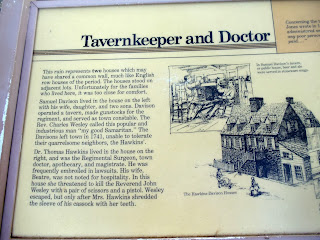Now, here's something I never saw before! Duane and I had swapped helmets with Brock and Leola. When they traded their Goldwing for a Spyder, their communications system went with the bike. We offered to let them test our system as part of their quest for a new system.
In case you didn't remember, Duane's helmet is black. This is a front view of the new Spyder, which has two wheels in the front and one in back.
To help break in the new bike, we rode with them one day to a little restaurant to join our shrimping friends for a $10 shrimp buffet. But weren't you catching shrimp to eat? you ask. Yes, but these shrimp are already cooked! There were 14 at our table, and they were too busy stuffing face to pose. I can't blame them--the shrimp was delicious.
On our way home we detoured for a visit to the local HD store.
One day when we didn't have anything planned we rode bicycles along a very small part of the miles of paved hike/bike path. We rode to the pier then looped along the wildlife viewing trail.
There wasn't a whole lot of wildlife in view, but I managed to spot this horseshoe crab in the tidewater flat at low tide.
Just as I got back on my bike, I saw something trotting down the path ahead of me. Guess what it is.
One of the many resident raccoon.
Our rv park is very shady with an abundance of Georgia pines and live oak trees. I looked outside one night for the moon and found this gem.
For the first long ride for the Spyder, we rode 60 miles to St. Mary's to inquire about taking the ferry to Cumberland Island National Seashore. We cruised the visitors center, reading about the island first. It is a national parks site so visiting it would be free, but the ferry ride is $18 each so we decided against a visit. (We wouldn't have minded the price if the money went to the parks service, but the ferry is run by a private contractor.) From what we read in the visitors center, the island is uninhabited but was once the home of the Carnegies. There are a few ruins to explore, but most activities are limited to walking the hike/bike path or shoreline, viewing wildlife, and fishing. We can do all of these things on Jekyll Island, including visiting ruins. We finished our education in the visitors center, took a couple of pix, and headed home.
Cumberland Island is in the horizon.
Since the National Parks Service was back in business, we were also able to visit Ft. Frederica on St. Simon's Island. We started with the St. Simon's Sweet Shop for ice cream for lunch. Literally! Then it was on the bikes for a ride to the north end of the island.
Fort Frederica and the town of Frederica were established as a military outpost on the Colonial Georgia frontier. From 1736 to 1749 the fort and its regimental garrison were the hub of the British military operations on Georgia's frontier. The town was peopled by "worthy poor" people--prominent English citizens who needed a new start. The first settlers consisted of 44 men who were mostly skilled workers and 72 women and children.
The fort was built first with attendant storehouses, then the town was laid out in 84 lots, most 60x90 ft. Each family received a lot for building and 50 country (outside the town) acres for crops. Over time the settlers replaced their palmetto huts with houses built of wood, tabby, and brick in the Georgian style. Orange trees shaded the main road, 75'-wide Broad Street, which ran from the fort to the town gate. The town was surrounded by a 10 ft. palisade and a 10 ft deep moat. The dirt dug from the moat was thrown as earthworks between the palisade and the moat. The town was also guarded by bastions on the corners.
Archaeologists have uncovered most of the bases of the houses along Broad St. There were info boards for each one. This was particularly interesting.
Part of the fort.
You all know what this is.
This is thought to be the forge in the blacksmith shop which was within the fort walls.
This shows how the houses would have been divided on the ground floor. The circle on the left is an oven. This was working space mostly. Since the lots were small, living space could be added by going up--a lot of houses had second and third floors.
Soldiers' quarters. Other soldiers built palmetto huts outside the walls.
Taking a break on one of the many nice benches placed around the town site.
View of the town area. Try to imagine it with houses instead of trees.
Time and sediments have filled in a lot of the moat.
Cemetery
This road led from the town gate to Ft. St. Simon's, 6 miles south. The British fought the Spaniards there and not far from the town gate.
After touring the town site, we visited the visitors center to stamp our National Parks Passports. We view the exhibits and the short film then headed for home.We really enjoy our visits to National Sites and and very glad they are all open again.
Join us later for more adventures!
Louise and Duane



























2 comments:
That looks like a huge raccoon. Is it true that if a raccoon is out in the day, it could be sick?
Awesome moon photo.
I honestly have to say that I have never heard of Fort Frederica. Thanks for the tour.
Hopefully we can get to that Fort. Jeff would really enjoy it.
Post a Comment